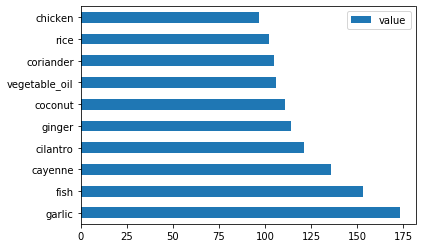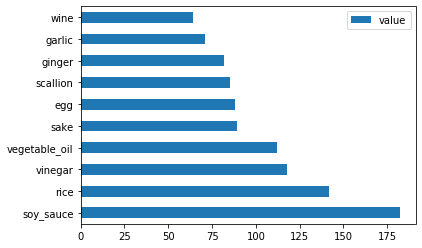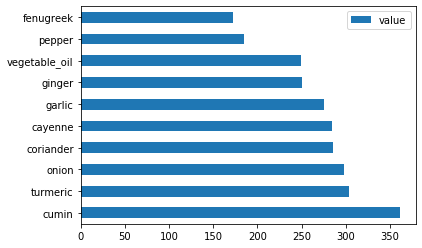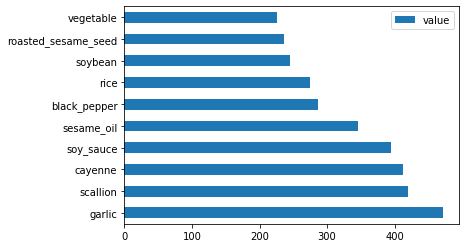|
|
4 years ago | |
|---|---|---|
| .. | ||
| images | ||
| solution | 4 years ago | |
| translations | ||
| README.md | ||
| assignment.md | ||
| notebook.ipynb | 4 years ago | |
README.md
Introduction to Classification
In these four lessons, you will discover the 'meat and potatoes' of classic machine learning - Classification. No pun intended - we will walk through using various classification algorithms with a dataset all about the brilliant cuisines of Asia and India. Hope you're hungry!
Classification is a form of supervised learning that bears a lot in common with Regression techniques. If machine learning is all about assigning names to things via datasets, then classification generally falls into two groups: binary classification and multiclass classfication.
🎥 Click the image above for a video: MIT's John Guttag introduces Classification
Remember, Linear Regression helped you predict relationships between variables and make accurate predictions on where a new datapoint would fall in relationship to that line. So, you could predict what price a pumpkin would be in September vs. December, for example. Logistic Regression helped you discover binary categories: at this price point, is this pumpkin orange or not-orange?
Classification uses various algorithms to determine other ways of determining a data point's label or class. Let's work with this recipe data to see whether, by observing a group of ingredients, we can determine its cuisine of origin.
Pre-lecture quiz
Introduction
Classification is one of the fundamental activities of the machine learning researcher and data scientist. From basic classification of a binary value ("is this email spam or not?") to complex image classification and segmentation using computer vision, it's always useful to be able to sort data into classes and ask questions of it. Or, to state the process in a more scientific way, your classification method creates a predictive model that enables you to map the relationship between input variables to output variables.
Before starting the process of cleaning our data, visualizing it, and prepping it for our ML tasks, let's learn a bit about the various ways machine learning can be leveraged to classify data.
Derived from statistics, classification using classic machine learning uses features, such as 'smoker','weight', and 'age' to determine 'likelihood of developing X disease'. As a supervised learning technique similar to the Regression exercises you performed earlier, your data is labeled and the ML algorithms use those labels to classify and predict classes (or 'features') of a dataset and assign them to a group or outcome.
✅ Take a moment to imagine a dataset about recipes. What would a multiclass model be able to answer? What would a binary model be able to answer? What if you wanted to determine whether a given cuisine was likely to contain Fenugreek? What if you wanted to see if, given a present of a grocery bag full of star anise, artichokes, cauliflower, and horseradish, you could create a typical Indian dish?
Hello 'classifier'
The question we want to ask of this recipe dataset is actually a multiclass question, as we have several potential national cuisines to work with. Given a batch of ingredients, which of these many classes will the data fit?
Scikit-Learn offers several different algorithms to use to classify data, depending on the kind of problem you want to solve. In the next two lessons, you'll learn about several of these algorithms.
Clean and Balance Your Data
The first task at hand before starting this project is to clean and balance your data to get better results. Start with the blank notebook.ipynb file ini the root of this folder.
The first think to install is imblearn. This is a Scikit-Learn package that will allow you to better balance the data (you will learn more about this task in a minute).
pip install imblearn
Then, import the packages you need to import your data and visualize it. Import SMOTE from imblearn.
import pandas as pd
import matplotlib.pyplot as plt
import matplotlib as mpl
import numpy as np
from imblearn.over_sampling import SMOTE
The next task will be to import the data:
df = pd.read_csv('../data/recipes.csv')
Check the data's shape:
df.head()
The first five rows look like this:
| Unnamed: 0 | cuisine | almond | angelica | anise | anise_seed | apple | apple_brandy | apricot | armagnac | ... | whiskey | white_bread | white_wine | whole_grain_wheat_flour | wine | wood | yam | yeast | yogurt | zucchini | |
|---|---|---|---|---|---|---|---|---|---|---|---|---|---|---|---|---|---|---|---|---|---|
| 0 | 65 | indian | 0 | 0 | 0 | 0 | 0 | 0 | 0 | 0 | ... | 0 | 0 | 0 | 0 | 0 | 0 | 0 | 0 | 0 | 0 |
| 1 | 66 | indian | 1 | 0 | 0 | 0 | 0 | 0 | 0 | 0 | ... | 0 | 0 | 0 | 0 | 0 | 0 | 0 | 0 | 0 | 0 |
| 2 | 67 | indian | 0 | 0 | 0 | 0 | 0 | 0 | 0 | 0 | ... | 0 | 0 | 0 | 0 | 0 | 0 | 0 | 0 | 0 | 0 |
| 3 | 68 | indian | 0 | 0 | 0 | 0 | 0 | 0 | 0 | 0 | ... | 0 | 0 | 0 | 0 | 0 | 0 | 0 | 0 | 0 | 0 |
| 4 | 69 | indian | 0 | 0 | 0 | 0 | 0 | 0 | 0 | 0 | ... | 0 | 0 | 0 | 0 | 0 | 0 | 0 | 0 | 1 | 0 |
Get info about this data:
df.info()
<class 'pandas.core.frame.DataFrame'>
RangeIndex: 2448 entries, 0 to 2447
Columns: 385 entries, Unnamed: 0 to zucchini
dtypes: int64(384), object(1)
memory usage: 7.2+ MB
Learning about cuisines
Now the work starts to become more interesting. Let's discover the distribution of data, per cuisine:
df.cuisine.value_counts().plot.barh()
There are a finite number of cuisines, but the distribution of data is uneven. You can fix that! Before doing so, explore a little more. How much data exactly is available per cuisine?
thai_df = df[(df.cuisine == "thai")]
japanese_df = df[(df.cuisine == "japanese")]
chinese_df = df[(df.cuisine == "chinese")]
indian_df = df[(df.cuisine == "indian")]
korean_df = df[(df.cuisine == "korean")]
print(f'thai df: {thai_df.shape}')
print(f'japanese df: {japanese_df.shape}')
print(f'chinese df: {chinese_df.shape}')
print(f'indian df: {indian_df.shape}')
print(f'korean df: {korean_df.shape}')
thai df: (289, 385) japanese df: (320, 385) chinese df: (442, 385) indian df: (598, 385) korean df: (799, 385)
Discovering ingredients
Now you can dig deeper into the data and learn what are the typical ingredients per cuisine. You should clean out recurrent data that creates confusion between cuisines, so let's learn about this problem.
Create a function in Python to create an ingredient dataframe. This function will start by dropping an unhelpful column and sort through ingredients by their count:
def create_ingredient_df(df):
ingredient_df = df.T.drop(['cuisine','Unnamed: 0']).sum(axis=1).to_frame('value')
ingredient_df = ingredient_df[(ingredient_df.T != 0).any()]
ingredient_df = ingredient_df.sort_values(by='value', ascending=False
inplace=False)
return ingredient_df
Now you can use that function to get an idea of top ten most popular ingredients by cuisine:
thai_ingredient_df = create_ingredient_df(thai_df)
thai_ingredient_df.head(10).plot.barh()
japanese_ingredient_df = create_ingredient_df(japanese_df)
japanese_ingredient_df.head(10).plot.barh()
chinese_ingredient_df = create_ingredient_df(chinese_df)
chinese_ingredient_df.head(10).plot.barh()
indian_ingredient_df = create_ingredient_df(indian_df)
indian_ingredient_df.head(10).plot.barh()
korean_ingredient_df = create_ingredient_df(korean_df)
korean_ingredient_df.head(10).plot.barh()
Now, drop the most common ingredients that create confusion between distinct cuisines. Everyone loves rice, garlic and ginger!
feature_df= df.drop(['cuisine','Unnamed: 0','rice','garlic','ginger'], axis=1)
labels_df = df.cuisine #.unique()
feature_df.head()
Balance the dataset
Now that you have cleaned the data, use SMOTE - "Synthetic Minority Over-sampling Technique" - to balance it. This strategy generates new samples by interpolation.
oversample = SMOTE()
transformed_feature_df, transformed_label_df = oversample.fit_resample(feature_df, labels_df)
By balancing your data, you'll have better results when classifying it. Think about a binary classification. If most of your data is one class, a ML model is going to predict that class more frequently, just because there is more data for it. Balancing the data takes any skewed data and helps remove this imbalance.
Now you can check the numbers of labels per ingredient:
print(f'new label count: {transformed_label_df.value_counts()}')
print(f'old label count: {df.cuisine.value_counts()}')
new label count: korean 799
chinese 799
indian 799
japanese 799
thai 799
Name: cuisine, dtype: int64
old label count: korean 799
indian 598
chinese 442
japanese 320
thai 289
Name: cuisine, dtype: int64
The data is nice and clean, balanced, and very delicious! You can take one more look at the data using transformed_df.head() and transformed_df.info(). Save a copy of this data for use in future lessons:
transformed_df.to_csv("../../data/cleaned_cuisine.csv")
This fresh CSV can now be found in the root data folder.
🚀Challenge
This curriculum contains several interesting datasets. Dig through the data folders and see if any contain datasets that would be appropriate for binary or multi-class classification? What questions would you ask of this dataset?
Post-lecture quiz
Review & Self Study
Explore SMOTE's API. What use cases is it best used for? What problems does it solve?






